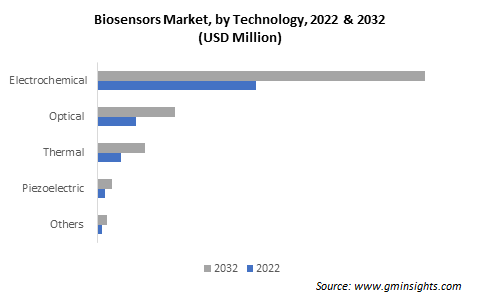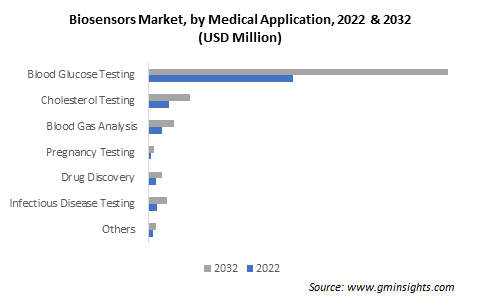Home > Healthcare > Medical Devices > Medical Supplies > Biosensors Market
Biosensors Market Analysis
- Report ID: GMI747
- Published Date: Dec 2022
- Report Format: PDF
Biosensors Market Analysis
Based on type, the biosensors market is bifurcated into non-wearable and wearable biosensors. Among these, the non-wearable biosensors segment is poised to grow at over 4.5% CAGR from 2023 to 2032. Rising incidences of respiratory disorders, CVDs, and blood pressure-related ailments are likely to foster the segment outlook. Non-wearable biosensors incorporate innovative technology that allows them to yield fast and timely results in various healthcare settings. Devices such as handheld meter-and-strip-based measuring systems are integral as they help monitor creatinine, ketone, lactate, and glucose effectively.

On the basis of technology, the biosensors market is divided into piezoelectric, optical, thermal, electrochemical, and others. The optical segment is expected to grow at over 7% CAGR from 2023 to 2032, owing to the rising application scope of optical biosensing devices in healthcare, biomedical, and biopharmaceutical sectors. This technology helps healthcare professionals measure pCO2 in surgical monitoring and critical care settings. Optical biosensors are also capable of offering new analytical tools with compact size as well as high-throughput screening of a multitude of samples for various parameters, which further drives their demand.

In terms of medical application, the biosensors market is categorized into drug discovery, infectious disease testing, blood gas analysis, pregnancy testing, blood glucose testing, cholesterol testing, and others. The market size from infectious disease testing segment is expected to exceed USD 2.5 billion by 2032. Biosensors offer numerous benefits over other analytical tools, such as real-time detection, low cost, the potential for portability and miniaturization, high sensitivity and selectivity, rapid response times, and use of small sample volumes.
Biosensors also offer a sensitive, inexpensive, and easy-to-use platform that aids rapid pathogen detection and effective treatment prediction. Micro as well as nanotechnological advancements have given biosensors the ability to perform complex molecular assays for infectious disease diagnosis.

Based on end-use, the research laboratories segment valuation is anticipated to surpass USD 6 billion by 2032, fueled by increasing focusing on the development of affordable biosensors that can help with early detection and monitoring of chronic diseases. These laboratories boast of state-of-the-art research facilities and an experienced team dedicated towards product innovation and improving patient lives. Moreover, increasing public and private investments towards research study upgradation, and construction of new research laboratories is also likely to shape the segment scenario. In recent years, such investments have led to the development of novel biosensors for tissue engineering and cell culture.

Asia Pacific biosensors market is slated to reach over USD 16.3 billion by 2032, driven by the rising prevalence of numerous infectious diseases in the region. In addition, growing government as well as individual healthcare expenditure is also expected to outline the regional outlook. Introduction of several health initiatives by domestic governments, WHO, and organizations such as Clinton Health Access Initiative, Inc. (CHAI), are also fuelling regional statistics.

